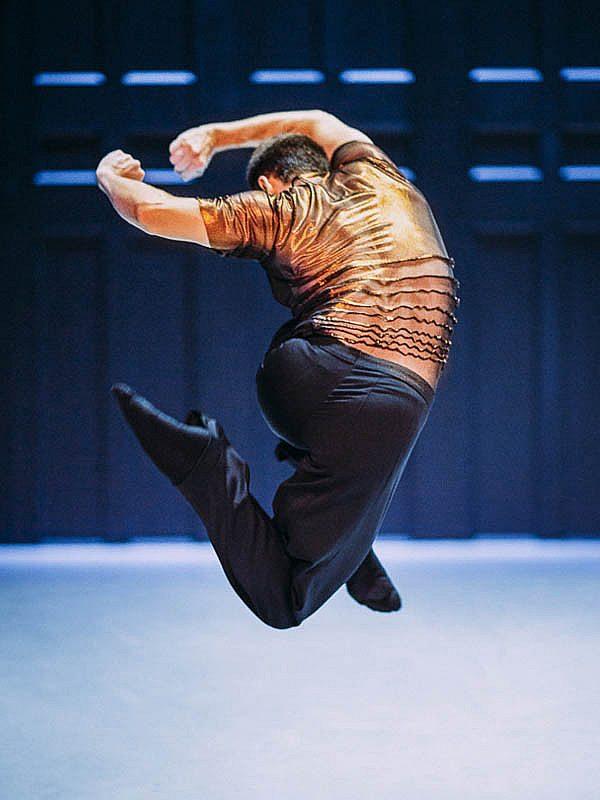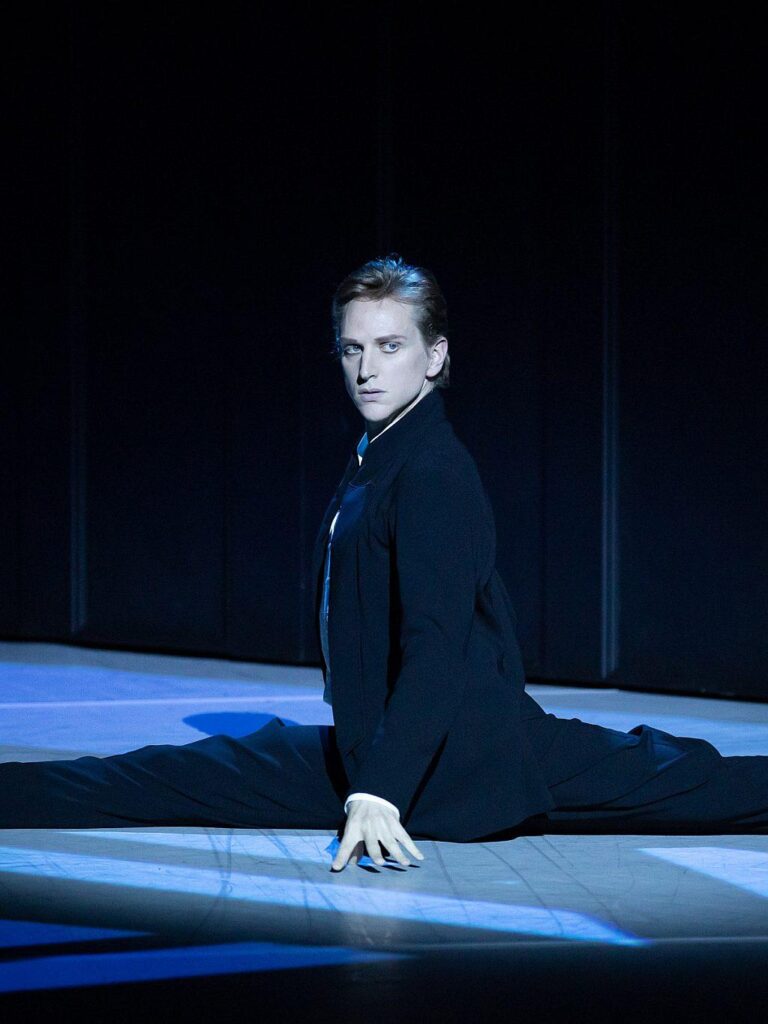Never before has The Australian Ballet presented contemporary dance of this scale and ambition. Commissioned for the 60th anniversary of Nederlands Dans Theater, the world’s most celebrated contemporary company, and now presented for the first time outside of the Netherlands by The Australian Ballet, Kunstkamer is the joint creation of four choreographers: frequent collaborators Paul Lightfoot and Sol León; Marco Goecke; and the Canadian prodigy Crystal Pite.
Inspired by the 18th-century cabinet of curiosities, this work draws together diverse elements – stark movement, song, film, spoken word – into an eclectic and fascinating whole, bound together by recurring motifs and characters and featuring music by a vast array of composers from Beethoven to Bach to Britten, Janis Joplin to Joby Talbot.
The choreography, moving from the intimacy and humour of solos and pas de deux to intricate waves of ensemble movement, references dance theatre traditions while exploring new frontiers of expression.
Like a modern museum curated with wit and incisive intelligence, Kunstkamer invites you to wonder at the endless possibilities of art.













We’ve compiled a handy ‘A to Z’ guide for all things Kunstkamer. This will help you wrap your head around the intricate details of this production, its background, the creatives involved, and a host of other facts you might not know about the work. Our research has taken us from science, to art, from Beethoven to butterflies and back again. This guide covers everything you need to know about the ‘beautiful monster’ that is Kunstkamer. It’s ballet amplified!
Albertus Seba
An 18th century Dutch pharmacist, zoologist and collector who owned one of the most extensive and varied ‘cabinets of curiosities’ during his time. He had his entire collection of natural specimens documented in a four-volume feat, Albertus Seba’s Cabinet of Natural Curiosities. This mesmerising publication embodies the intersection of art and science, and it was a creative seed for Kunstkamer choreographers Sol León and Paul Lightfoot, who had the opportunity to engage with the original volumes in The Hague’s Royal Library.
Béla Bartók
Bartók is a Part I ensemble piece choreographed by Paul Lightfoot, set to String Quartet no. 4 Allegretto Pizzicato by Hungarian composer Béla Bartók. The score is defined by a peculiar scale, with emphasis on each note of the strings coming together in the quartet. This reflects the role of the individual dancer within the ensemble on stage, mirroring Kunstkamer’s seamless shift from the singular, to the group, and back again.
Crystal Pite
Canadian-born Crystal Pite is one of Kunstkamer’s four co-creators. Crystal’s choreographic career spans three decades, and she has created works for world-leading dance companies. She is also the founding artistic director of Vancouver-based dance company Kidd Pivot, which has earned a reputation for producing radical dance-theatre hybrids that thrill and challenge audiences. Kunstkamer sees Crystal co-create Beethoven with Paul Lightfoot in Part I, and Schubert Memory in Part II.
…It is an honour for me to inhabit the world of Kunstkamer with Paul, Sol and Marco, and heartening to know the beautiful dancers of The Australian Ballet are bringing Kunstkamer back to life
Crystal Pite
Dutch
Kunstkamer is inherently a Dutch work. It was created under the direction of Paul Lightfoot for the 60th anniversary of Nederlands Dans Theater. Its connection to The Netherlands also resonates through the conceptual thread of Albertus Seba, who was also Dutch. Kunstkamer first premiered in October 2019 at Zuidersatrand Theater in The Hague.
Forever A Second Déjà Vu
The second work in Part II of Kunstkamer, this emotive pas de deux is choreographed by Sol León and set to Arvo Pärt’s Fratres for violin, string orchestra and percussion. Audiences will observe how this work uses dynamic levels and side-by-side choreography to evoke the shapes of butterfly wings and insect-like silhouettes as they appear in Seba’s book, and also in the work of German-born naturalist and illustrator Maria Sybilla Merian.
Gluck
Christoph W. Gluck was a composer of Italian and French opera in the early classical period. His composition Orfeo ed Euridice: Dance of the furies is the selected score accompanying Paul Lightfoot’s ensemble spectacle Gluck in Part II. This piece mirrors the group formations of specimens in Seba’s book, with a focus on structure and order. Soon enough you might start to see what looks like a group of Belenois calypso (tropical butterflies) darting about on stage.
Henry
Choreographed by Marco Goecke, Henry in Part II of Kunstkamer is set to compositions by English composer Henry Purcell. These include: King Arthur, Z. 628, Act 3: 22. ‘While The Cold Genius Arises’, King Arthur, Z. 628, Act 3: 27. ‘See, See We Assemble’ and King Arthur, Z. 628, Act 3: 27a.
Janis Joplin
Janis Joplin’s unmistakable twang registers Kunstkamer’s refreshing and varied contemporary music repertoire. Marco Goecke’s Janis (Part I) explores the emotional resonance of Joplin’s Ball and Chain and So Sad to Be Alone through group ensembles and more intimate choreography. The powerful harmony of Joplin’s voice and Goecke’s choreography will linger in your mind.
Kunst-Kamer
What on earth does the title of this work really mean? As described by Director and co-creator Paul Lightfoot, ‘kunst’ means ‘art’, and ‘kamer’ means ‘room’. Kunstkamer therefore literally means ‘room of art’. This concept is the basis of a visual metaphor running through the show, expressed not only through reference to Albertus Seba’s book, but also through the sparse black set that acts as ‘house’ or room for memories, energies and of course a universal creative spirit expressed through movement.
Lament (Dido and Aeneas)
Listen out for Henry Purcell’s poignant composition Lament from the opera Dido and Aeneas. Dido’s Lament is the aria When I am laid in earth, a hauntingly beautiful piece.
Marco Goecke
German choreographer Marco Goecke is one of Kunstkamer’s four co-creators. Marco’s choreographic repertoire includes works performed by Canadian National Ballet, Ballett-Theater in Munich, the Finnish National Ballet in Helsinki, the Stanislavsky Theater in Moscow and the Vienna State Opera, among many others. In Kunstkamer, Marco has created the works Janis in Part I, and Johan and Henry in Part II.
Seeing Kunstkamer come to life again at The Australian Ballet fills me with great pride. The energy and emotion of this work will not only live on, but it will unite new artists and audiences across the world. This is the power of dance as an art form
Marko Goecke
Nederlands Dans Theater
Originally created for Nederlands Dans Theater’s (NDT) 60th anniversary, Kunstkamer strengthens the bond between The Australian Ballet and this world-leading contemporary dance company based in The Hague. NDT has pushed the boundaries of the art form for decades, thrilling audiences with thought-provoking dance experiences that defy conventions. A number of the world’s most inventive choreographers have enriched NDT through ground-breaking works created for the company, including Paul Lightfoot and Sol León.
Ode to Joy
Co-created by Paul Lightfoot and Crystal Pite, Beethoven is a rousing Part I ensemble spectacle set to Ode to Joy, one of Ludwig van Beethoven’s most-loved compositions. Uplifting and triumphant, say no more!
Paul Lightfoot
Kunstkamer Director and co-creator Paul Lightfoot reflects that Albertus Seba’s book provided the perfect metaphor to frame a work celebrating the artistry and diversity of NDT. In bringing the concept to life, he gave each of the choreographers free reign to impart their own voice and vision to the work. While Kunstkamer was created for NDT’s 60th anniversary, it embodies a universal celebration of human connection and community, with infinite opportunity for it to come to life anywhere in the world.
You could compare Kunstkamer to a museum, where you look from Munch to Rembrandt to Pollock, and even though these works are from different centuries, and they have nothing directly to do with each other, you do feel a thread or a spirit uniting them
Paul Lightfoot
Que te vaya bonito
A tender and poignant musical interlude that opens Part II by Spanish composer José Sandoval, performed by Costa-Rican-born Mexican singer Chavela Vargas (recording). This piece demonstrates the more poignant side of Kunstkamer’s music repertoire.
Rothschildia Hesperus
The scientific name of a ‘very large tropical moth’ as documented in Albertus Seba’s book. You will notice references to moths and butterflies in motifs on costumes designed by Joke Visser and Hermien Hollander.
Sol León
León explores the idea of characters in her parts, which include Overture, Near Light, Forever A Second Déjà vu, Forgiveness, and Öldurót. Audiences will observe how León’s sections have a softer, more intimate, character focus. This is in contrast to Paul Lightfoot’s sections, which are stylistically more rigid and structured with a focus on the ensemble. While Lightfoot was inspired by Albertus Seba’s book in creating Kunstkamer, it is perhaps less known that León felt more deeply connected to the work of entomologist and scientific illustrator Maria Sybilla Merian, who illustrated her intimate observations of the natural world and documenting the symbiosis between living organisms.
“Seba’s approach was scientific, but Merian’s was both scientific and spiritual. Her interpretation of the ecosystem felt more intimate to me. Seba was all about quantity, his view of the organisms felt very structured, ordered and masculine. Merian’s work felt softer, with a more feminine energy that inspired me to explore characters and narratives in my choreography,” she says.
Kunstkamer symbolises an imaginary and infinite place that has gathered incredibly beautiful souls that collectively create a constant flow of possibilities
Sol Leon
Talbot
British composer Joby Talbot is widely known for his work across film and TV scores, vocal concert music and pop arrangements. Paul Lightfoot’s Part II work Past Present is set to Talbot’s Chacony in G minor (after Purcell).
Udo Haberland, Tom Bevoot and Tom Visser
This artistic trio from The Netherlands created the original lighting design for NDT’s Kunstkamer. Enhancing the enigmatic atmosphere of the work, Kunstkamer’s lighting ranges from stark spotlights to ethereal backlighting in hues of blue and yellow, to a floodlight-style effect for ensemble sections illuminating the entire stage.
Violin Solos
Orchestra Victoria and Opera Australia Orchestra’s Concertmasters will be delivering solo violin performances in Kunstkamer across both seasons: Jun Yi Ma and Huy-Nguyen Bul (Sydney) and Sulki Yu and Yi Wang (Melbourne).
Words (sung and spoken)
In a first for The Australian Ballet, Kunstkamer sees dancers engage with a thrilling mix of sung and spoken words on stage. Listen out for the ensemble singing in Part II’s Henry, and See See, We Assemble. If you’ve been excited by body percussion on stage in past contemporary works, you have another thing coming!
Xyleutes Strix
Scientific name for a species of moths from Malay Archipelago, New Guinea and America, as documented in Albertus Seba’s book. Purchase a copy of our Kunstkamer Souvenir Program at your performance to discover exclusive illustrations of these flora and fauna species by local Victorian artist and illustrator Paula Zetlein.
